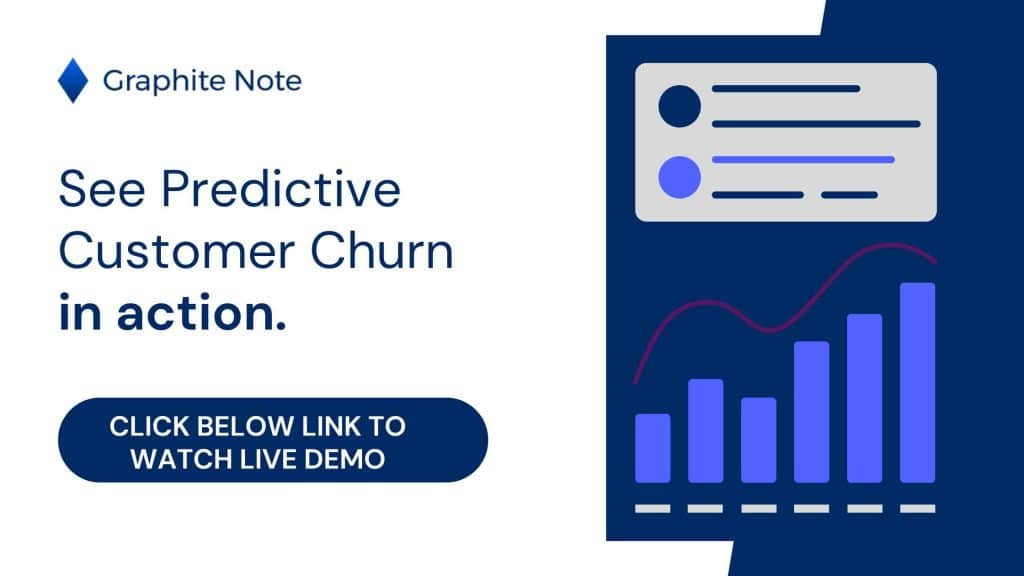Customer churn, also known as customer turnover or customer attrition, is a critical metric that measures the rate at which customers stop doing business with a company over a specific time period. Understanding and managing customer churn rates is important to help you maintain a healthy customer base and ensure long-term success. Predictive analytics can help you lower your churn rate and ensure better business performance.
The Importance of Customer Churn Analysis
Customer churn analysis is vital for several reasons. Your customer churn is important to understand, because it helps you predict churn and act to keep your customer. A high customer churn rate can be a concern for any business, and specifically a SaaS company. Predictive analytics can help you understand involuntary churn, revenue churn, negative churn, and more. Predictive analytics helps you keep valuable customers, support your current customers, and improve customer support if needed. Excellent customer service is a key way to prevent a high churn rate, as you work towards a lower churn rate or a good churn rate. Predictive analytics helps you identify customer needs, create customer retention strategies, and understand your customer acquisition cost. Effective customer churn analysis can help you strategize to lower a high churn rate. It’s also important to understand your average churn rate and revenue churn rate. Your customer churn analysis helps you understand:
- Revenue churn: High churn rates can significantly affect a company’s bottom line. Acquiring new customers is often more expensive than retaining existing ones. New subscribers are always more expensive to get, compared to keeping your current subscribers happy. Predictive analytics helps you figure out your churn rate formula so you can optimize towards generating new revenue, understanding your average revenue, or enhance your business growth rate.
- Customer lifetime value: Reducing churn helps maximize customer lifetime value, leading to increased profitability. If your customers have had a negative experience with your business, predictive analytics can help you identify any concerns. Your customer may share their experience on social media. You can then empower your support team to focus on keeping your current customers happy, while growing your total number of customers. Finding new ones is often more difficult and costly than managing your current customers. Attracting new revenue channels can also be difficult. Understanding these important metrics is made easier with predictive analytics.
- Your business health: Churn rates provide insights into customer satisfaction and the overall health of a business.
- Your competitive advantage: Companies with lower churn rates often have a competitive edge in the market.
Calculating Your Customer Churn Rate
Your customer churn rate measures the percentage of customers lost over a specific time period. To calculate it, use the following formula:
Customer Churn Rate = (Churned Customers / Total Customers at the Start of Period) x 100
For example, if a company starts with 1,000 customers and loses 50 over a month, the monthly churn rate would be 5%.
Understanding the Concept of Customer Churn
To effectively reduce customer churn, you need to analyze customer behavior and identify factors contributing to customer attrition. Some common causes of churn include:
- Poor customer service.
- Inadequate product quality.
- Lack of customer engagement.
- Competitive offerings.
- Pricing issues.
Predictive analytics can help you identify key contributing factors to your customer churn rate.
Strategies to Improve Customer Retention and Reduce Churn
- Enhance customer experience: Provide exceptional customer service and personalized interactions to boost customer satisfaction.
- Implement customer feedback loops: Regularly collect and act on customer feedback to address pain points and improve products or services.
- Develop strong customer relationships: Foster loyalty through consistent communication and value-added interactions.
- Offer incentives for loyal customers: Reward repeat customers with exclusive offers or loyalty programs.
- Optimize the customer journey: Ensure a smooth onboarding process and provide ongoing support throughout the customer lifecycle.
- Use predictive analytics: Implement churn prediction models to identify at-risk customers and take proactive measures.
- Focus on customer success: Establish a dedicated customer success team to help customers achieve their goals with your product or service.
Leveraging Data for Churn Prevention
Effective churn prevention relies heavily on data analysis:
- Customer data: Analyze customer interactions, purchase history, and engagement metrics to identify patterns and potential churn indicators.
- Churn metrics: Monitor key performance indicators (KPIs) such as customer satisfaction scores, Net Promoter Score (NPS surveys), and account health.
- Segmentation: Divide your customer base into segments to tailor retention strategies for different customer groups.
- Predictive modeling: You can use machine learning algorithms to forecast churn probability and identify high-risk customers. Using predictive analytics can greatly enhance your ability to forecast customer churn. Analyzing historical data and using advanced algorithms, you can identify patterns and trends that indicate potential churn risk. This empowers you to take proactive measures to retain customers and minimize revenue loss.
Customer Churn Analysis and Graphite Note
One of the key tools in churn prediction analysis is Graphite Note. A user-friendly platform, Graphite Note enables you to perform complex churn prediction analysis without the need for coding skills. With Graphite Note, you can easily access and analyze your data, identify churn risk factors, and develop effective strategies to mitigate customer attrition.Artificial Intelligence (AI) also plays a crucial role in churn prediction. AI algorithms can analyze vast amounts of data and identify subtle patterns and correlations that humans might miss. Using the power of AI, you can stay one step ahead and implement proactive measures to retain customers. AI algorithms can analyze customer behavior data, such as purchase history, browsing patterns, and customer interactions, to identify early signs of dissatisfaction or disengagement. By detecting these signals, you can intervene and take appropriate actions to address customer concerns, offer personalized solutions, and prevent churn. AI-powered sentiment analysis can help businesses understand customer feedback and sentiment towards their products or services. By analyzing customer reviews, social media posts, and support tickets, AI algorithms can identify common pain points and areas for improvement. This valuable insight can guide you in making data-driven decisions to enhance customer satisfaction and loyalty.
The Role of Customer Acquisition in Churn Management
While retention is important, customer acquisition remains an important aspect of managing overall churn:
- Balance acquisition and retention: Strive for a healthy mix of new customers and retained customers to offset inevitable churn.
- Optimize customer acquisition costs: Ensure that the cost of acquiring new customers doesn’t outweigh the potential lifetime value.
- Target the right audience: Focus your acquisition efforts on customers who are likely to have a good fit with your product or service, reducing the likelihood of early churn.

Conclusion
Managing customer churn is an ongoing process that requires continuous effort and analysis. Are you ready to take the next step in mastering customer retention and reducing churn? Discover how Graphite Note can empower your business with our no-code predictive analytics platform. Whether you’re a growth-focused team without AI expertise or an agency without a data science team, Graphite Note is designed to transform your data into precise predictions and actionable strategies. Turn insights into outcomes with ease. Request a Demo today.





